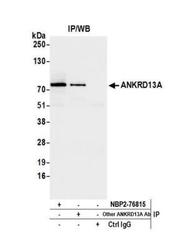Antibody data
- Antibody Data
- Antigen structure
- References [0]
- Comments [0]
- Validations
- Western blot [1]
- Immunoprecipitation [1]
Submit
Validation data
Reference
Comment
Report error
- Product number
- NBP2-76815 - Provider product page

- Provider
- Novus Biologicals
- Product name
- Rabbit Polyclonal ANKRD13A Antibody
- Antibody type
- Polyclonal
- Description
- Affinity purified. The epitope recognized by NBP2-76815 maps to a region between residue 500 and 550 of human Ankyrin repeat domain-containing protein 13A using the numbering given in entry Q8IZ07.3
- Reactivity
- Human, Mouse
- Host
- Rabbit
- Isotype
- IgG
- Vial size
- 100 ul
- Storage
- Store at 2 - 8 C 1 year from date of receipt
No comments: Submit comment
Supportive validation
- Submitted by
- Novus Biologicals (provider)
- Main image

- Experimental details
- Western Blot: ANKRD13A Antibody [NBP2-76815] - Detection of human ANKRD13A by western blot of immunoprecipitates. Samples: Whole cell lysate (1.0 mg per IP reaction; 20% of IP loaded) from Jurkat cells prepared using NETN lysis buffer. Antibodies: Affinity purified Rabbit anti-ANKRD13A antibody NBP2-76815 used for IP at 100 ul per reaction. For blotting immunoprecipitated ANKRD13A, NBP2-76815 was used at 1:1000. Detection: Chemiluminescence with an exposure time time of 3 seconds.
Supportive validation
- Submitted by
- Novus Biologicals (provider)
- Main image

- Experimental details
- Immunoprecipitation: ANKRD13A Antibody [NBP2-76815] - Detection of human ANKRD13A by western blot of immunoprecipitates. Samples: Whole cell lysate (1.0 mg per IP reaction; 20% of IP loaded) from Jurkat cells prepared using NETN lysis buffer. Antibodies: Affinity purified Rabbit anti-ANKRD13A antibody NBP2-76815 used for IP at 100 ul per reaction. ANKRD13A was also immunoprecipitated by another rabbit anti-ANKRD13A antibody. For blotting immunoprecipitated ANKRD13A, NBP2-76815 was used at 1:1000. Detection: Chemiluminescence with an exposure time time of 3 seconds.
 Explore
Explore Validate
Validate Learn
Learn Western blot
Western blot